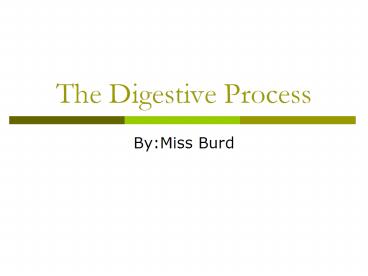The Digestive Process - PowerPoint PPT Presentation
1 / 14
Title:
The Digestive Process
Description:
Functions of the Digestive System ... the wall of the digestive system into your blood. ... The food is now released into the next part of the digestive system ... – PowerPoint PPT presentation
Number of Views:410
Avg rating:3.0/5.0
Title: The Digestive Process
1
The Digestive Process
- ByMiss Burd
2
Functions of the Digestive System
- 3 Main Functions
- Breaks down food into molecules the body can use
- Molecules are absorbed into the blood and carried
throughout the body - Wastes are eliminated
3
Functions of the Digestive System
- Digestion- process by which your body breaks down
food into small nutrient molecules. - 2 Types
- Mechanical
- Chemical
4
Functions of the Digestive System
- Mechanical Digestion
- Foods are physically broken down into smaller
pieces. - It occurs when you bite into food and chew them
into smaller pieces. - Smooth muscle in the
- stomach contract,
- mixing up food
5
Functions of the Digestive System
- Chemical Digestion
- Chemicals produced by the body break foods into
their smaller chemical building blocks - Example- Starch in bread is broken down into
individual sugar molecules - Now the molecules are ready to be transported
throughout the body - Absorption- the process by which nutrient
molecules pass through the wall of the digestive
system into your blood. - Materials that are not absorbed, such as fiber,
are eliminated as waste.
6
The Mouth
- Saliva- fluid released when your mouth waters
- Plays a role in both chemical and mechanical
digestion - Teeth- tear into food
- Saliva mixes with food and moistening them into a
slipper mass
7
The Mouth- chemical digestion
- Chemicals in saliva break down starch into sugar
molecules (tastes sweet) - Chemical digestion is accomplished by ENZYMES.
- Enzyme- a protein that speeds up chemical
reactions in the body - Each enzyme has a particular shape, which enables
it to take part in only ONE kind of chemical
reaction. - Examples- the enzyme that breaks down starch into
sugar can not break down proteins into amino
acids.
8
The Esophagus
- As you swallow, muscles in your throat
- move the food downward
- When you eat a flap of tissue in your
- throat, the epiglottis, seals off your
- windpipe, preventing food from entering.
- Food goes into the esophagus
- The esophagus is lined with mucus, a thick,
slippery substance produced by the body - Food stays in the esophagus for about 10 seconds
- Contractions of smooth muscles push the food
toward the stomach
9
The Esophagus
- Peristalsis- involuntary waves of smooth muscle
contactions
10
STOMACH
- Food enters the stomach from the esophagus
- Stomach- a j-shaped muscular pouch, located in
the abdomen - The stomach expands to hold all the food
- An average adult
- stomach holds 2
- liters of food
11
STOMACH
- Mechanical digestion occurs in the stomach, three
strong layers of muscle contract to produce a
churning motion - Squeezes the food and mixes it with fluids,
similar to a washer machine - Chemical digestion is taking place at the same
time - Digestive juices are produced by the lining of
the stomach
12
STOMACH
- Pepsin- enzyme in the digestive juices that
breaks down proteins into amino acids - Hydrochloric Acid- the digestive juices also
contain a strong acid - the acid kills most bacteria and pepsin works
best in an acid environment - Why doesnt the acid burn a whole in your stomach?
13
STOMACH
- The digestive juices also contain mucus, which
coats and protects the lining of your stomach - Cells that line the stomach are quickly replaced
when they are damaged or worn out - Food remains in the stomach until it is in liquid
form - Most of the protein has been chemically digested
into shorter chains of amino acids - The food is now released into the next part of
the digestive system
14
http//www.timeforkids.com/TFK/magazines/story/0,6
277,195276,00.html
- Did You Know?
- About 10 billion tiny scales of skin rub off your
body every day. In a lifetime, you could fill
eight 5-pound bags with dead skin. - Snot is a part of your daily diet. Humans swallow
about one quart of nose mucus every day. - The hydrochloric acid in your stomach is so
strong that it can eat up stainless steel razor
blades. - Your mouth is the most unsanitary part of your
whole body. More than 100,000,000 microcreatures
live there at any one time. That's more critters
than there are people in Australia, Canada and
Spain combined! - Ear wax coats the inside of the ear canal to trap
nasty stuff like dirt, dust and bugs. The wax
dries up, forms little balls and drops out when
you yawn, chew or swallow.































